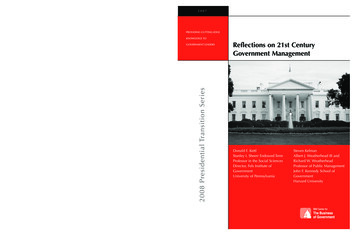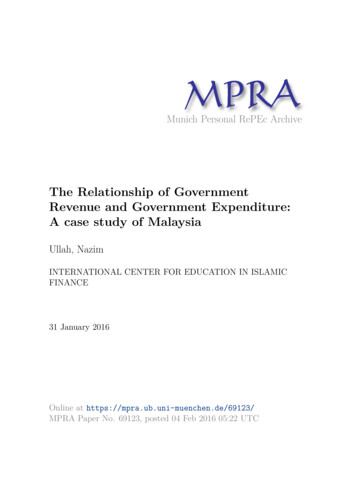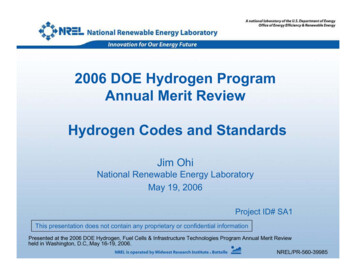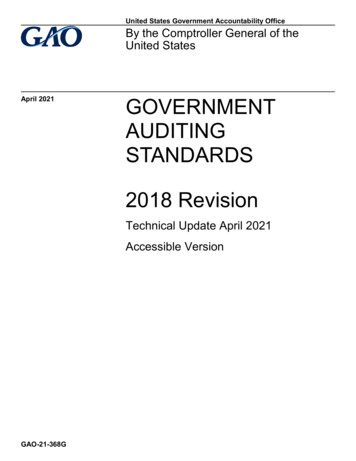
Transcription
Int. J. Technology, Policy and Management, Vol. 18, No. 1, 2018The role of government in Porter’s Diamond model:comparative cases of Singapore and ThailandJarunee WonglimpiyaratCollege of Innovation,Thammasat University,Anekprasong 3 Bldg., Prachan Rd.,Bangkok 10200, ThailandFax: (662) 623 5060Email: jaruneew@tu.ac.thAbstract: This paper explores the government dimension of Porter’s Diamondmodel. In particular, the study analyses the role of government to supporteconomics of innovation in the cases of Singapore and Thailand. The paperexamines the government policies including major tax policies and research anddevelopment tax incentives in promoting the high-tech industries in Singaporeand Thailand. The analyses of findings offer the policy learning of using taxpolicy as part of the science and technology policy instruments to fostertechnological innovations. The study gives insightful lessons which would beuseful for readers and policy makers to understand linkages between thegovernment role, innovation politics and major government policies to supportinnovation system development.Keywords: government policies; innovation politics; Porter’s Diamond model;tax policies; technology commercialisation.Reference to this paper should be made as follows: Wonglimpiyarat, J. (2018)‘The role of government in Porter’s Diamond model: comparative cases ofSingapore and Thailand’, Int. J. Technology, Policy and Management, Vol. 18,No. 1, pp.73–88.Biographical note: Jarunee Wonglimpiyarat, PhD, ACCA, CPA, CIA, CFE,CGAP, CFSA, CISA, CISM, CLP, RTTP is a member of the College ofInnovation, Thammasat University, Thailand. She holds a PhD in TechnologyManagement from Manchester Business School, University of Manchester, UKand has post-doctoral fellowships at Boston University and Harvard University,USA. She has worked at PricewaterhouseCoopers, Standard Chartered Bank,Citibank N A, Sussex Innovation Centre, Boston University TechnologyCommercialization Institute and the US Securities and Exchange Commission.She has won many awards for her research contributions including the ElsevierScopus Young Scientist Award, an award designed by Elsevier, the World’sleading research publisher of scientific information. She has been awarded forhaving the highest publications in international journals with the highest impactfactors.Copyright 2018 Inderscience Enterprises Ltd.73
741J. WonglimpiyaratIntroductionThe government policies play an important role in supporting the development of hightech industries. The analyses in this study are based on the theses of government policiesand financial economics of innovations. Many countries have used tax policies as one ofthe policy measures to induce innovations. Singapore and Thailand represent the twoAsian countries that use tax policies to drive economic growth. The analyses in this studyattempt to understand the innovation politics and economics of innovation by answeringthe research question: to what extent the tax policies have helped support the process oftechnology commercialisation in the country cases of Singapore and Thailand? The studyattempts to fill the gap in the existing literature with regard to policy studies on high-techentrepreneurship.Table 1 provides an overview of economies of Singapore and Thailand. The grossdomestic product (GDP) growth and competitiveness ranking of Singapore are muchbetter than Thailand despite the country’s fewer natural resources. Figure 1 compares thecompetitiveness ranking of Singapore and Thailand among other Asian countries duringthe years 2008–2015. According to the International Institute for ManagementDevelopment World competitiveness Yearbook 2015, Singapore was ranked on the thirdplace while Thailand was ranked in the 30th position.Table 1Overview of economies - Singapore and ThailandIndicatorYearSingaporeThailandPopulation (million)20155.667.9Gross domestic product (GDP) growth (%)20134.42.920142.80.7International Institute for ManagementDevelopment (IMD) world competitivenessranking2015330Ranking in scientific infrastructure20151647Ranking in technological infrastructure2015244Knowledge economy index (KEI) ranking20122366KEI index20128.265.21Source:The author’s design, based on the world competitiveness scoreboard(various years) by International Institute for ManagementDevelopment (IMD), World Bank
The role of government in Porter’s Diamond modelFigure 175Competitiveness ranking of some Asian countries, years 2008–2015 (see online versionfor colours)Source:The author’s design, based on the world competitiveness scoreboard(various years) by International Institute for ManagementDevelopment (IMD) (see online version for colours)This study analyses the innovation politics and economics of innovation with particularemphasis on the countries of Singapore and Thailand. The reasons to choose the two casecountries are that Singapore is the most advanced economy among the ASEAN countries,while Thailand is the second largest economy of the ASEAN countries. The structure ofthe paper is as follows. Section 2 reviews the theoretical framework on research anddevelopment (R&D) investments and government policies to support innovations as wellas Porter’s Diamond Model regarding the determinants of national innovative capacity.Section 3 explains the methodological framework. Section 4 presents the analyses offindings focused on tax policies and R&D tax incentives to foster high-tech start-ups incommercialising their innovations. Policy lessons and implications to support high-techentrepreneurship as well as conclusions are drawn in Section 5.2Theoretical framework2.1 R&D investments and government policies to support innovationsInnovation can be seen as a process that has linkages and feedbacks with and connects allthe elements of the Schumpeterian triad - invention, innovation and diffusion (Lundvall,1992, 1993, 1998, 1999, 2003; Nelson, 1993; Viotti, 2002). R&D can be seen as anecessary cost of business, since investments in R&D usually have an implication ofbuilding firms’ competitiveness. The diffusion of innovation depends largely on R&D.Importantly, R&D would enable the firms to pursue numerous options which could turnout to be strategic in the future. That is to say, capital investment is essential fortranslating technologies into commercialised innovations. Without R&D investments(investments in technology as a capital investment), there would have been no innovativecapacity, and consequently no new profits from it.The government plays an important role in building the national innovative capacity.The public policy measures such as R&D tax incentives, research grants, loans, public
76J. Wonglimpiyaratventure capital can have effects on the entrepreneurial, venture and economicdevelopment (Mani, 2004). Innovation policies are among the key operational priorities indeveloping countries to support investment by local firms, especially small- and mediumsized enterprises (SMEs) and transnational corporations investing in these countries(David et al., 2000; Hyytinen and Toivanen, 2005). Public policy intervention generallyaims at raising R&D investments particularly in developing countries. However, thedegree of state intervention depends largely on the potential of the private sector indeveloping an economy based on knowledge-based innovations (Mani, 2004).Cluster policies are among important mechanisms for improving the effectiveness ofthe national innovation system (Lundvall, 1992, 1993, 1998, 1999, 2003; Porter, 1985,1990, 2001). They have been recognised as an important innovation policy instrument tofacilitate innovation and support transdisciplinary research networks among academicsand entrepreneurs, which would thereby improve the capacity of nations. Clusters havedrawn substantial attention from policy makers, since clusters provide a framework forcatalysing economic transformation. The cluster policies derive from the successfultechnology cluster development at Silicon Valley and Boston Route 128 in the US(Saxenian, 1994, 2007). The mechanisms driving the development of Silicon Valley hightech clusters are the management of networked region: networks among entrepreneurs,venture capitalists, researchers and others to translate ideas into new commercialinnovations. The elements of Porter’s cluster model to build national innovative capacitywill be discussed in the next section.2.2 Porter’s Diamond model - determinants of national innovative capacityThe rise of high-technology clusters started with Michael Porter’s ‘CompetitiveAdvantage’ in 1985 (Porter, 1985). Porter, the most influential management analyst ofHarvard Business School, who is frequently cited in a conceptual thinking of ‘competitiveadvantage’, argues that the cluster of collaborating businesses helps in the rapiddissemination of innovations. The cluster is a geographically proximate group ofinterconnected companies and associated institutions in a particular field, linked bycommonalities and complementarities (Porter, 1990, 2001). The concept of ‘clusters’promotes collaboration among institutions to facilitate the exchange of information andtechnology.Porter’s Diamond model emphasises the role of government in creating anenvironment conducive to national competitive advantage. Porter argued that theinteractions between the various agents of the nation help achieve considerable synergy.The underlying benefits of clusters also include collective learning and knowledgespillovers among participating institutions. Porter’s Diamond model (Figure 2) provides aframework for understanding collaboration/networking between the government andindustry sectors in the form of clusters (Porter, 1990, 2001). The four attributes:1Factor conditions2Demand conditions3Context for firm strategy and rivalry4Related and supporting industries are self-reinforcing and catalyse the process ofcontinuous innovations.
The role of government in Porter’s Diamond model77The model focuses upon the conditions that drive national innovative capacity (Porter,1985, 1990, 1998, 2001).Figure 2Diamond model - the model of cluster determinantsSource: Porter (1990, 2001)Saxenian (1990, 1994, 2007) coined a similar concept of regional advantage to promotethe clusters/regional networks for creating network-based industrial system. Taking intoaccount the role of cluster in the economics of innovations, clusters drive innovation andinnovation drives productivity which in turn have influences on economic developmentand national competitiveness (Porter, 1985, 1990, 1998, 2001; Lai et al., 2014; Broekelet al., 2015).3Research methodologyThere is a wealth of literature on the economics of innovation and entrepreneurship.However, to date only limited research has been carried out to explore the aspects ofinnovation politics and government policies in regards to technology commercialisation(Mani, 2004). Therefore, it seems reasonable to explore the government policies withparticular focus on tax policies and government R&D tax incentives governing thenational innovation system. According to the survey concerning SME financing gap bythe Office of Small and Medium Enterprises Promotion (OSMEP) of Thailand, the issueof tax incentives is one of the major obstacles to SME growth and development. Thissuggests that the area of tax policies to support high-tech entrepreneurship needs furtherempirical investigation.This study aims to fill a gap in existing research of innovation politics andgovernment policies in supporting high-tech entrepreneurship. The empirical research
78J. Wonglimpiyaratresults can help bridge the tax policy approach to innovation system development. Theanalyses in this study attempt to understand the innovation politics and economics ofinnovation by answering the research question: To what extent the tax policies havehelped support the process of technology commercialisation in the country cases ofSingapore and Thailand?The research framework is outlined in Figure 3 to show the connections between thetheoretical framework and case study analyses. The comparative analyses of Singaporeand Thailand would provide important insights and lessons on innovation politics and therole of government in shaping the direction of the national innovation system – the use oftax policies to support technology commercialisation and innovation system development.This research employed a case study methodology and involved 30 interviews. Theinterviews were carried out with the tax authorities, government agencies and companieshaving experiences of government services. The interview data were supported by anexamination of secondary data in order to provide a cross-check on the validity ofresearch (Yin, 2013). The conduct and analyses of comparative case studies enable thedevelopment of conclusions and policy recommendations for the research. The researchfindings provide evidence-based lessons and experiences that can be applied to otherdeveloping economies under varying implementation environments.Figure 3Research frameworkSource: The author’s design4Tax policies and R&D tax incentives to promote high-tech start-upsSingapore and Thailand represent the two Asian countries that use tax policies to driveeconomic growth and innovation. Both countries pursue a developmental state role infostering the economics of innovation. Based on the cluster model (Porter, 1990, 2001),Figures 4 and 5 provide an analysis of the determinants of national innovative capacity in
The role of government in Porter’s Diamond model79the country cases of Singapore and Thailand, respectively. The government of Singaporehas been successful in supporting high-tech start-ups through effective policies to enhancethe landscape of the country. This includes adopting the US model and makingappropriate changes to suit the economy of Singapore. In the case of Thailand, althoughthe country has far more resources than Singapore, Thailand suffers from lack of effectivepolicies to support early stage start-ups and chronic political unrest apart from poorlinkages among various actors in the innovation system.Figure 4Determinants of national innovative capacity - SingaporeSource:Figure 5The author’s design, based on the framework by Porter (1990, 2001)Determinants of national innovative capacity - ThailandSource:The author’s design, based on the framework by Porter (1990, 2001)
80J. WonglimpiyaratFigures 6 and 7 investigate further the government dimension of Porter’s DiamondModel. They provide detailed analysis of the major government policies affectingtechnology commercialisation and influencing the innovation system development in thecountry cases of Singapore and Thailand, respectively. By mapping national politicalleadership to each phase of economic development, the figures reflect the impacts ofinnovation politics on the functioning of their innovation systems.Figure 6Innovation politics and major government policies to support innovation systemdevelopment in SingaporeSource:Figure 7The author’s design (adapted from Wong, 2011; Wong et al., 2007)Innovation politics and major government policies to support innovation systemdevelopment in ThailandSource:The author’s designIn the case of Singapore, the government policy in an early stage of industrial take-off(1960s) was highly dependent on technology transfer from foreign multinationalcompanies. Prime Minister Lee Kuan Yew’s development strategy after independence in1963 was mainly focused on foreign investments. The Economic Development Board(EDB) was specifically established to attract foreign investors to locate their operations inSingapore. In the 1970s–1980s, the policy emphasis was on local technological deepening- encouraging domestic firms to absorb foreign technology with the aim of deepening and
The role of government in Porter’s Diamond model81upgrading technological base. The government policies during this period were focusedon attracting foreign direct investments (from multinational companies). The governmentlaunched various financing schemes and policy measures to encourage and assist localenterprises in upgrading, strengthening and expanding their operations. Prime MinisterGoh Chok Tong’s strategy in the 1990s was focused on innovation and creative research.The Agency for Science, Technology and Research (A*STAR) was established to overseethe development of Singapore’s R&D capabilities. The government policies emphasisedthe establishment of public R&D institutions as well as encouraged co-fundingmechanisms to attract R&D investments in areas of economic importance to Singapore.At present, Singapore is gearing towards knowledge-based economy. The governmentpolicies under Prime Minister Lee Hsien Loong are focused on technologycommercialisation and high-tech entrepreneurship.In the case of Thailand, the government policies were strategically focused on importsubstitution industrialisation in the 1960s and export-oriented industrialisation in the1970s–1990s. The Thaksinomics policy was a major policy framework promoting thedevelopment of SMEs and entrepreneurship from 2000s onwards. At present, thegovernment policies are aimed at enabling Thailand to transition from a middle-incometrap to the high-income economy. Compared to Singapore which has a stable politicalenvironment, Thailand suffers from chronic political instability. Singapore has only 3political leaders running the country from 1960s to present. Nevertheless, Thailand has 28political leaders and 7 coups over the same period. The frequent changes of governmentresult in unstable economic environment and fragmented policies. Thailand’s economiclandscape was hard hit by the two major financial crises (the Asian financial crisis in1997 and the global financial crisis during 2007–2009). The economic growth of Thailandwas stagnant again by Bangkok Shutdown protests in 2014 whereby the militaryhad staged a coup to end political unrest. The unstable political economy of Thailandthereby results in incoherent and passive industrial policies to support high-techentrepreneurship.Taking into account the government policies to support high-tech start-ups, thegovernments of two countries have enacted tax policies and offered R&D tax incentivesto promote high-tech start-ups (Table 2). In the case of Singapore, the government usestax policy as part of its science and technology (S&T) policy instruments to fostertechnological innovations. A wide range of investment tax incentives including taxcredits, tax holidays, tax allowances, accelerated depreciation scheme, concessionary taxrates are offered to support high-tech SMEs. Tax incentives are given particularly toforeign multinational companies in order to facilitate the transfer of manufacturingtechnologies embodied in foreign direct investments (FDI) to domestic Singaporean firms(FDI knowledge spillover). The country also has a higher level of flexibility and policycoordination than Thailand’s from competent program management of EconomicDevelopment Board (EDB). At present, the Singaporean government offerscompetitive tax regime in attempts to promote high-tech entrepreneurship and drive thecountry towards the goal of biomedical hub.
82J. WonglimpiyaratTable 2CountrySingaporeMajor tax policies and R&D tax incentives to support high-tech industry in Singaporeand ThailandTypes ofprograms/activitiesDetails of tax policies and R&D tax incentives programsR&D incentive forstart-up enterprises(RISE)The program supports the needs of R&D-intensive startups by allowing them to convert tax losses to cash grantsduring their early years of product developmentTax incentives forventure capital fundsand venture capital(VC) fundmanagementcompaniesThe program provides tax exemption for approvedventure capital funds regarding capital gains. The capitalloss from VC investments can be expensed (100%maximum write-off). The scheme also gives taxexemption for management fees and performancebonuses that VC firms’ executives received for a periodof 10 years. The government plans to give a 5%concessionary tax rate to approved VC corporationsmanaging section 13H funds on qualifying incomePioneer incentiveFull corporate tax exemption on qualifying profits for upto 15 yearsDevelopment &expansion incentive(DEI)The incentive program offered by EDB aims atencouraging companies to move into high value-addedbusiness activities by reducing tax rate from 5 to 15% onincremental income from qualifying activitiesProductivity andinnovation credit(IRAS)IRAS gives tax credits up to SGD 400,000 of theirexpenditure per year for a range of innovation activitiesincluding not just acquisition of automation equipmentand training, but also design expenditure, R&D andregistration and acquisition of intellectual property (IP)Approved foreign loan(AFL)The AFL incentive of EDB provides a reduced tax rateof 0, 5 or 10% on interest payments on loans taken topurchase productive equipmentInvestment allowance(IA)The IA program encourages investments in equipmentthat contributes to greater efficiency in resourceutilisation or introduces new technology to the industryby giving tax deduction up to 5 years, or up to 8 yearsfor purchase of qualifying equipment on hire purchaseApproved royaltiesincentive (ARI)The ARI tax incentive scheme offers reducedwithholding tax on royalty payments to access advancedtechnology and know-howS19B writing-downallowancesS19B gives an automatic 5-years write-down for IPacquisitionDouble tax deduction(DTD) for marketdevelopment, masterfranchising and masterintellectual propertylicensingThe DTD program provides 200% tax deduction oneligible expenses to promote their products and servicesin overseas markets
The role of government in Porter’s Diamond modelTable 2CountryThailand83Major tax policies and R&D tax incentives to support high-tech industry in Singaporeand Thailand (continued)Types ofprograms/activitiesDetails of tax policies and R&D tax incentives programsProductivity andinnovation credit (PIC)and PIC schemesThe schemes provide allowance of 400% on up to SGD4,00,000 of qualifying expenditure incurred per year forthe activities involving intellectual property (IP)management such as acquisition and leasing of PICinformation technology and automation equipment,intellectual property (IP) licensing of rights, investmentsin approved design projectsApproved royaltiesincentive (ARI)The program offers reduced or nil withholding tax rateon royalty payments to access advanced technology andknow-howTransport technologyinnovationdevelopment scheme(TIDES)The program provides specific tax exemptions to supportthe automobile industry. TIDES supports EDB’s effortsin attracting automobile companies to undertakeknowledge-based manufacturing, R&D activities andtesting of vehicles in SingaporeTax exemption forstart-upsThe program offers tax exemption for the first SGD1,00,000 of chargeable income (excluding Singaporefranked dividends) for any of the first 3 years of taxassessment. A further 50% exemption is given on thenext SGD 2,00,000 of the normal chargeable incomeAngel investors taxdeduction scheme(AITD)The program administered by SPRING encourages angelinvestors to invest in start-ups by offering a 50% taxdeductionSkills, technology &innovation program(STI)The program is offered by the board of investment(BOI). STI aims to improve internationalcompetitiveness of Thailand in terms of attractingforeign investors and promoting exports. The qualifyingcompany will be given an additional 1-year corporateincome tax exemption provided total exemption perioddoes not exceed 8 years (corporate income taxexemptions, exemption of import duties and removal ofcorporate income tax exemption cap)Tax incentives forventure capitalindustryThe government offers tax exemption for capital gains ofVC corporations investing in SMEs. Dividend incomeand gains from the transfer of shares in SMEs are alsoexempted from corporate income tax up to 10 yearsprovided that certain requirements are met. The investorsco-investing with VC funds are exempted from personalincome tax. VC corporations that will be eligible for taxexemptions must invest in technologies of 10 industries:food and agriculture; energy saving and clean energy;textiles; advanced materials; biotechnology; health andmedical; tourism and creativity; automobiles and autoparts; electronics and computer software; and researchand innovation. However, the government does notallow write-off of the VC investments in case of failure
84J. WonglimpiyaratTable 2CountryMajor tax policies and R&D tax incentives to support high-tech industry in Singaporeand Thailand (continued)Types ofprograms/activitiesDetails of tax policies and R&D tax incentives programs300% tax incentive forR&D expenditureThe program allows 300% deduction for depreciation ofmachinery and equipment used in R&D activities. Theprogram is jointly managed by the Research andDevelopment Certification Committee Secretariat (RDC)of the National Science and Technology DevelopmentAgency (NSTDA) (under the Ministry of Science andTechnology) and the Revenue Department (under theMinistry of Finance) to encourage SMEs undertakingR&D activitiesAccelerateddepreciation rate forR&D equipmentThe incentive program offers 40% depreciation onmachines, equipment and apparels used in R&D. Theinvestors can enjoy the benefits of accelerateddepreciation in the first year of investmentTax concessions forSMEsSME companies are exempt on the first THB 300,000 ofnet profits. They are required to pay a reduced rate of15% corporate income tax on net profits exceeding THB300,000 up to THB 1 million and 20% on net profitsexceeding THB 1 million in 2014 and 2015Tax loss carry forwardThe government allows tax loss carry forward for theperiod of 5 yearsTax exemption forinnovative companiesThe government gives exemption of corporate incometax for a period of 5 years for innovative companiesregistered during 1 October 2015–31 December 2016Board of investment(BOI) tax incentiveschemeBOI offers tax benefits to foreign companies investing inThailand. The normal BOI package gives exemption ofimport duty on machinery, equipment, raw materials andexemption of corporate income tax up to 8 yearsdepending on investment zonesTax incentives foruniversity-industryresearch collaborationThe incentive program encourages companies to conductR&D activities in collaboration with the researchinstitutions or universities approved by BOI. Theprogram offers exemption of import duty on machinery,equipment, raw materials as well as exemption ofcorporate income tax for 70% of R&D expenditure for 3years (not exceeding THB 10 million)Special incentives forspecial innovationzones (SIZ)The SIZ program offers 10-years corporate income taxexemption without cap. The program expert’s income isexempted from personal income tax for the first 5 yearsand will be taxable at 10% flat rate after 5 yearsSource:The author’s design, based on Deloitte (2014, 2015) and Wong (2011)Unlike Singapore, the tax policies and R&D tax incentive programs of Thailand (Table 2)still lag behind in terms of varieties and effectiveness. In the case of Thailand, the policydesign to encourage R&D investments is in the form of income tax allowances (R&Dexpenditures are fully deductible from taxable income in the year they are incurred) andinvestment tax credits (tax credits allow the deduction of a certain percentage of R&Dexpenditures against the firm’s tax liability). The government offers R&D tax incentives
The role of government in Porter’s Diamond model85targeted to specific industrial sectors in order to enhance competitiveness of industries.The tax instruments are used to encourage firms to invest more in R&D which would helpimprove the level of technological development. The tax incentives would benefit thefirms in terms of income tax exemption. Currently, the Thai government sees theupcoming ASEAN economic integration (AEC) as a market opportunity and tries toencourage firms to conduct more R&D undertakings in order to increase employment andimprove GDP growth.From empirical analyses and interviews, large companies in Thailand generallyintegrate their R&D strategies as a key element of their corporate strategies. They seem toenjoy tax benefits more than small firms due to their close connections with thegovernment agencies. Most interviewees viewed that the 200% R&D Tax Relief programin the past did not much incentivise the private sectors to undertake R&D.1 Theycomplained about the steps in the application process for the Research and DevelopmentCertification Committee Secretariat (RDC) program that took so long in getting projectapproval by the Revenue Department (under the Ministry of Finance) and the NationalScience and Technology Development Agency (under the Ministry of Science andTechnology). The interviewees suggested that the targeted industries for R&D taxschemes should not be sector specific. They argued that by supporting the companies tosucceed at an early stage of development no matter in what industry they are, this wouldhelp raise awareness of the RDC program to the public. They also complained about thepublicity of the RDC program and its activities, since the industry and the private sectorswere not well informed of the program.Taking into account the effectiveness of the tax programs, the interviewees viewedthat the attitudes of the Revenue Department, which focus on tax investigations to collectmore tax revenues, seem to be a barrier to building trust with the taxpayers who claim thetax incentives. The management of companies argued that the decisions on R&Dinvestments to some degree were not made because of tax incentives. If they regarded thatR&D spending was essential to their businesses, they would undertake R&D regardless ofwhether the government gave such incentives or not. Many companies viewed that theRevenue Department was not sincere in providing tax benefits to the public. If there wer
2.2 Porter's Diamond model - determinants of national innovative capacity The rise of high-technology clusters started with Michael Porter's 'Competitive Advantage' in 1985 (Porter, 1985). Porter, the most influential management analyst of Harvard Business School, who is frequently cited in a conceptual thinking of 'competitive











